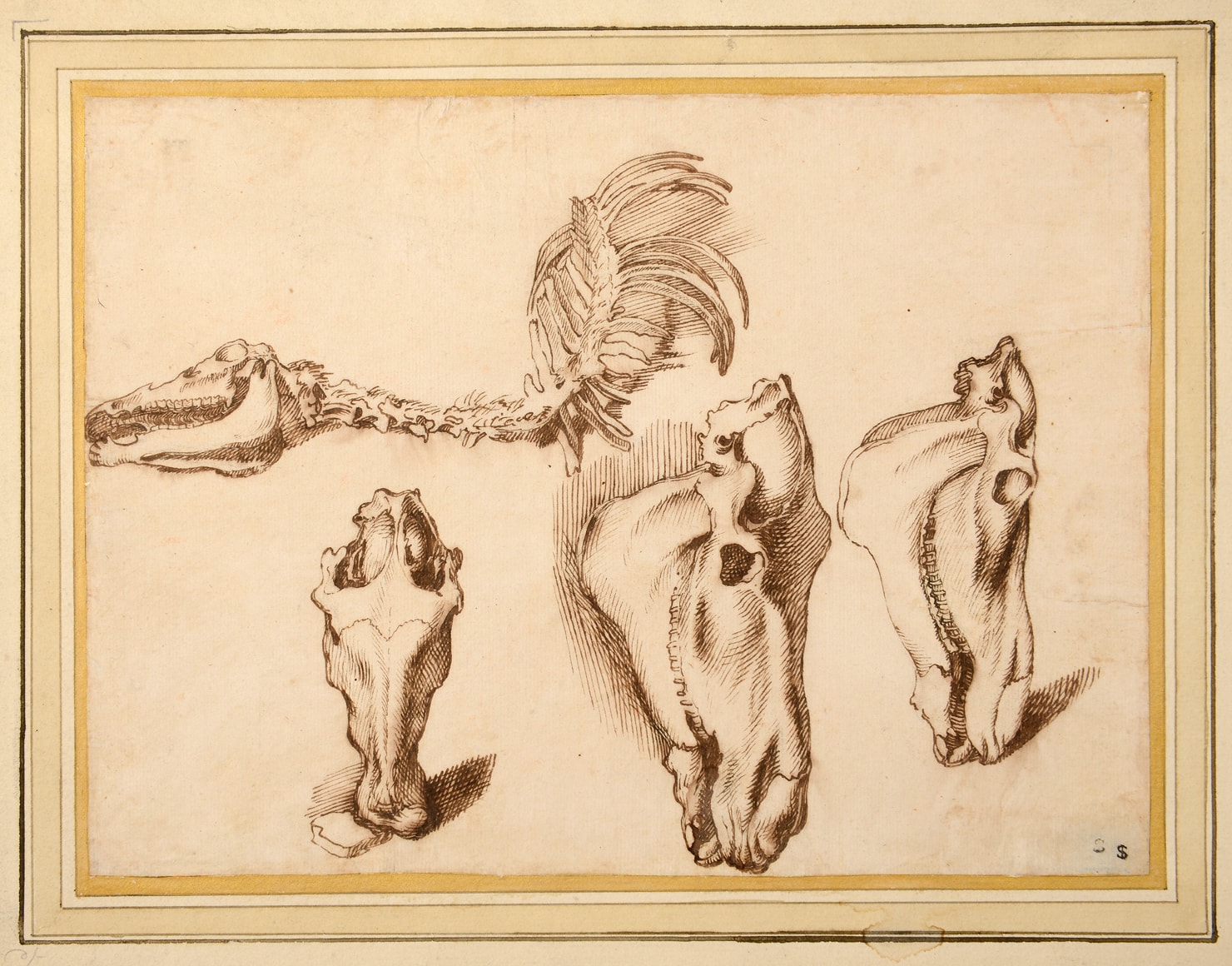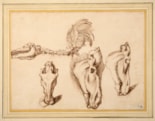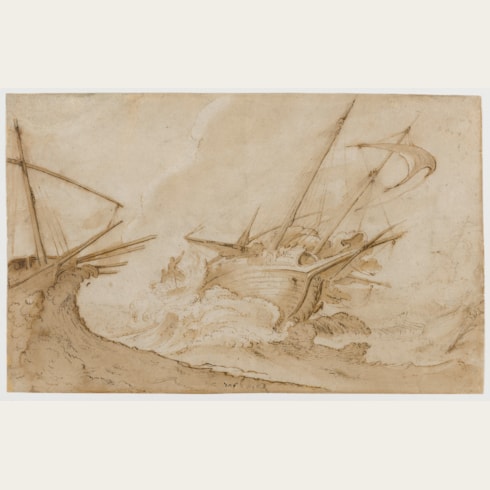Filippo NAPOLETANO
(Naples or Rome 1589 - Rome 1629)
Studies of the Skull and Skeleton of a Horse
Sold
Pen and brown ink.
Laid down on an 18th century English mount.
Inscribed Christie 20 June 22 [...] 43. / d and Paseroti on the reverse of the mount.
Further inscribed with a shelfmark L / No 13 on the reverse of the mount.
203 x 287 mm. (8 x 11 1/4 in.)
Laid down on an 18th century English mount.
Inscribed Christie 20 June 22 [...] 43. / d and Paseroti on the reverse of the mount.
Further inscribed with a shelfmark L / No 13 on the reverse of the mount.
203 x 287 mm. (8 x 11 1/4 in.)
Long attributed to the Bolognese artist Bartolomeo Passarotti (1529-1592), and more recently given to the Genoese draughtsman Sinibaldo Scorza (1589-1631), this fine drawing was independently attributed to Filippo Napoletano by Hugo Chapman and the late Marco Chiarini. Napoletano produced a number of prints and drawings (the latter in both pen and ink and chalk) of animal skeletons, and was recognized by his contemporaries as an expert in anatomical studies of this type. As the writer and art dealer Giulio Mancini noted of Napoletano in 1621, ‘he earned a reputation and esteem for himself particularly in small things of fires, ships and animals, and was highly regarded for certain extravagant pictures of animal skeletons.’
Between 1620 and 1621 Napoletano executed a series of etchings of animal skeletons entitled Incisioni di diversi scheletri di animali. The only extant complete set of these etchings, numbering twenty-one prints in all, is in an album in the Biblioteca Nazionale in Florence, although a set of modern impressions, taken from nineteen of the surviving plates, is in the Uffizi. The Incisioni di diversi scheletri di animali was the artist’s most celebrated series of prints executed during his Florentine period, and was dedicated to the German physician and scientist Johannes Faber (1574-1629), the papal doctor, anatomist and botanist whom Napoletano had met as a young artist in Rome. Faber had a strong interest in animal anatomy, and had assembled a study collection of around one hundred human and animal skeletons at his home near the Pantheon. It is thought that Faber commissioned Napoletano to produce a series of etchings of his skeletons, a project that was not begun before the artist left Rome in 1617 to settle in Florence. The work was eventually completed by August 1621, and was possibly delivered to Faber by the artist himself, who returned to Rome following the death of Cosimo II in February of that year. As Richard Wallace has noted of Napoletano’s etchings from the Incisioni di diversi scheletri di animali series, ‘Liagno attempted to make his prints rather more than simple illustrations of various skeletons, although they are basically accurate in purely scientific terms.’ Furthermore, in the words of Philip Hofer, ‘Here the scientific, the macabre, and a baroque sense of decoration are all happily combined.’
Only a handful of preparatory drawings by Napoletano for the Incisioni di diversi scheletri di animali are known, however, including a drawing of the skeleton of a horse, in the Biblioteca Nazionale in Florence, and a study of a mouse skeleton in the Louvre. This sheet of studies of the skull and part of the skeleton of a horse reflects Napoletano’s close study of Johannes Faber’s collection of animal skeletons, and may also be tentatively related to his etching of the complete skeleton of a horse from the Incisioni di diversi scheletri di animali. Stylistically comparable pen and ink drawings of parts of animal skeletons by Napoletano are among the nearly one hundred drawings by the artist the Musée des Beaux-Arts in Lille, including a study of the skull of a pelican, a drawing of the skull of a pig or boar, and a sheet with two studies of the skull of a goat.
The present sheet is first recorded, in the latter half of the 18th century, in the collection of the Earls Spencer at Althorp in Northamptonshire. At the Spencer sale in 1811, it was sold, together with another drawing, both as by Bartolomeo Passarotti (‘Passerotto. Two – studies of Horses’ bones, and of horses’ heads – both masterly pen’). The other drawing in the lot was probably the pen and ink study by Passarotti of a horse’s head and skull, bearing the Spencer collector’s mark, which was later in the collection of the 19th century antiquarian Francis Douce and is now in the Ashmolean Museum in Oxford.
Between 1620 and 1621 Napoletano executed a series of etchings of animal skeletons entitled Incisioni di diversi scheletri di animali. The only extant complete set of these etchings, numbering twenty-one prints in all, is in an album in the Biblioteca Nazionale in Florence, although a set of modern impressions, taken from nineteen of the surviving plates, is in the Uffizi. The Incisioni di diversi scheletri di animali was the artist’s most celebrated series of prints executed during his Florentine period, and was dedicated to the German physician and scientist Johannes Faber (1574-1629), the papal doctor, anatomist and botanist whom Napoletano had met as a young artist in Rome. Faber had a strong interest in animal anatomy, and had assembled a study collection of around one hundred human and animal skeletons at his home near the Pantheon. It is thought that Faber commissioned Napoletano to produce a series of etchings of his skeletons, a project that was not begun before the artist left Rome in 1617 to settle in Florence. The work was eventually completed by August 1621, and was possibly delivered to Faber by the artist himself, who returned to Rome following the death of Cosimo II in February of that year. As Richard Wallace has noted of Napoletano’s etchings from the Incisioni di diversi scheletri di animali series, ‘Liagno attempted to make his prints rather more than simple illustrations of various skeletons, although they are basically accurate in purely scientific terms.’ Furthermore, in the words of Philip Hofer, ‘Here the scientific, the macabre, and a baroque sense of decoration are all happily combined.’
Only a handful of preparatory drawings by Napoletano for the Incisioni di diversi scheletri di animali are known, however, including a drawing of the skeleton of a horse, in the Biblioteca Nazionale in Florence, and a study of a mouse skeleton in the Louvre. This sheet of studies of the skull and part of the skeleton of a horse reflects Napoletano’s close study of Johannes Faber’s collection of animal skeletons, and may also be tentatively related to his etching of the complete skeleton of a horse from the Incisioni di diversi scheletri di animali. Stylistically comparable pen and ink drawings of parts of animal skeletons by Napoletano are among the nearly one hundred drawings by the artist the Musée des Beaux-Arts in Lille, including a study of the skull of a pelican, a drawing of the skull of a pig or boar, and a sheet with two studies of the skull of a goat.
The present sheet is first recorded, in the latter half of the 18th century, in the collection of the Earls Spencer at Althorp in Northamptonshire. At the Spencer sale in 1811, it was sold, together with another drawing, both as by Bartolomeo Passarotti (‘Passerotto. Two – studies of Horses’ bones, and of horses’ heads – both masterly pen’). The other drawing in the lot was probably the pen and ink study by Passarotti of a horse’s head and skull, bearing the Spencer collector’s mark, which was later in the collection of the 19th century antiquarian Francis Douce and is now in the Ashmolean Museum in Oxford.
Teodoro Filippo di Liagno, called Filippo d’Angeli but better known as Filippo Napoletano, was a pupil of his father, an artist working in Rome, although he seems to have completed his education in Naples. Around 1614 he returned to Rome, where he encountered the landscape paintings of Agostino Tassi, whose work is sometimes confused with his, and was also influenced by the paintings of Caravaggio and his followers, as well as the German painter Adam Elsheimer. By 1617 he was in Florence, where he was employed alongside Jacques Callot at the court of the Grand Duke Cosimo II de’ Medici. (Indeed, Filippo Baldinucci states that Napoletano was one of Cosimo’s favourite artists). He remained in Florence until 1621 before returning to Rome, where he worked on the decoration of a number of villas and palaces, notably a group of landscape frescoes in the Palazzo Bentivoglio, completed in 1623, and a series of seascapes for the Palazzo Barberini. For the remainder of his career Napoletano worked in both Rome and Naples, producing cabinet pictures of battle scenes, landscapes and marine subjects for private collectors. He also painted a large number of religious and mythological subjects in a distinctive technique of oil on different types of variegated and coloured stone, known as pietra paesina. As a draughtsman, Napoletano was much admired by contemporary collectors such as Cardinal Leopoldo de’ Medici, as well as later connoisseurs like Pierre-Jean Mariette in the 18th century. Significant groups of drawings by the artist are today in the Uffizi, the Louvre and the Musée des Beaux-Arts in Lille.
Provenance
The Hon. John Spencer, Althorp, Northamptonshire
By descent to George John, 2nd Earl Spencer, Althorp, Northamptonshire (Lugt 1530 twice)
His sale, London, T. Philipe, 10-18 June 1811, part of lot 346 (as Bartolomeo Passarotti)
Anonymous sale, London, Christie’s, 20 June 1822, part of lot 43
Possibly Francis Douce, London
Iohan Quirijn van Regteren Altena, Amsterdam
By descent to his wife, Augusta Louisa Wilhelmina van Regteren Altena, née van Royen, Amsterdam, until 2001
Sale, London, Sotheby’s, 11 July 2001, lot 13 (as Sinibaldo Scorza)
Kate de Rothschild and Yvonne Tan Bunzl, London.
By descent to George John, 2nd Earl Spencer, Althorp, Northamptonshire (Lugt 1530 twice)
His sale, London, T. Philipe, 10-18 June 1811, part of lot 346 (as Bartolomeo Passarotti)
Anonymous sale, London, Christie’s, 20 June 1822, part of lot 43
Possibly Francis Douce, London
Iohan Quirijn van Regteren Altena, Amsterdam
By descent to his wife, Augusta Louisa Wilhelmina van Regteren Altena, née van Royen, Amsterdam, until 2001
Sale, London, Sotheby’s, 11 July 2001, lot 13 (as Sinibaldo Scorza)
Kate de Rothschild and Yvonne Tan Bunzl, London.
Literature
Amsterdam, Rijksmuseum, Italiaanse Tekeningen uit een Amsterdamse Particuliere Verzameling, exhibition catalogue, 1970, p.22, no.57, illustrated p.76 (as Bartolomeo Passarotti); Corinna Höper, Bartolomeo Passarotti, Worms, 1987, Vol.II, p.112, no.Z 9 and p.176, under no.Z 273 (as Passarotti, not illustrated); Carel van Tuyll van Serooskerken, The Italian Drawings of the Seventeenth and Eighteenth Centuries in the Teyler Museum, Leiden and Haarlem, 2021, Vol.II, p.455.
Exhibition
Amsterdam, Rijksmuseum, Italiaanse Tekeningen uit een Amsterdamse Particuliere Verzameling, April-June 1970, no.57 (as Bartolomeo Passarotti); London, Kate de Rothschild, Drawings and Sketches, 2003, no.1 (as Passarotti).





